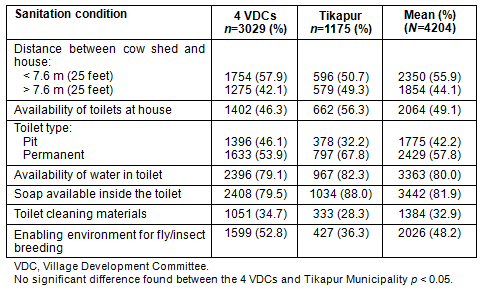Dear Editor
Nepal is among the least developed countries in Asia, and 80% of the population live in rural areas. Hygiene and sanitation are generally poor in Nepal with 36% of the people practicing defecation in fields or bushes1. A structured survey was conducted from June to September 2012 at the five sites of Tikapur Municipality and four surrounding Village Development Committees (VDCs) in Kailali, far-western Nepal.
Among 4204 households surveyed, 97.3% used tube wells for drinking water with 4% using purification, 1.3% boiling the water before drinking, 0.1% used water filtered through fabric, and 0.5% used chlorination. In addition, the quality of drinking water at the study sites was evaluated using Inductively Coupled PlasmaMass Spectrometry (ICP-MS). The results were a high manganese level (mean 2.262 mg/L) exceeding the 0.05 mg/L standard level for safe drinking water, but the arsenic level was within guidelines despite a recent report that 4% of tube wells in Kailali district had high levels of arsenic2. In urban areas such as Kathmandu, arsenic, chloride, fluoride and water hardness have been reported to be in agreement with WHO guidelines, but iron and coliform bacteria exceed the standards3. In other developing countries such as Bangladesh and India, disease outbreaks and worm infestation were reported to be due to consumption of contaminated tube-wells4,5.
An earlier WHO report stated that sanitation supply coverage in rural Nepal was 65% lower than in urban areas6. In the present study, liquid and solid waste management and other sanitation-related observations were investigated and found to be unsatisfactory with almost half of the respondents lacking a permanent toilet inside their houses (Table 1). This lack of access to safe waste disposal leads to some villagers disposing of their excreta near to water sources, therefore contaminating the water supply and risking water-borne infections.
This assessment will be used to design a developmental scheme to secure Tikapur's public health situation. Specifically, this study has created an awareness of the process of and need for water purification. By promoting the habit of drinking purified water, communicable diseases may be better controlled and prevented. Currently, toilets are being established in some households, and female health volunteers have been educated to disseminate drinking safe water and good sanitation habits.
Table 1: Distribution of sanitation conditions in households responding to sanitation-related questions (N=4204)

Acknowledgements
This research was supported by the National Research of Korea Grant funded by the Korean Government (NRF-2010-413-B00024) and by the Korea Ministry of Environment as 'The Eco-Innovation project (Global Top Project)'.
Kyu-Jae Lee MD, PhD1,5, Yang-Suk Yoon MS1, Ma Easter Joy Sajo BSc1, Chun-Bae Kim PhD2,
Narendra Khanal MD3, Young-Ah Do MS4, Pan-Suk Kim PhD5, Dong-Won Ahn PhD5
1Department of Environmental Medical Biology, 2Preventive Medicine,
Wonju College of Medicine, Yonsei University,
5Institute for Poverty Alleviation and International Development, Wonju, Gangwon,
4Management Support Team, Management Support Department,
Korea International Cooperation Agency, Seongnam, Gyeonggi,
Republic of Korea
3Tikapur Hospital, Tikapur, Kailali, Nepal
References
1. Nepal Ministry of Population and Health. Nepal Demographic Health Survey 2011. Kathmandu, Nepal: New ERA, and ICF International, 2012.
2. Yadav IC, Singh S, Devi NL, Mohan D, Pahari M, Tater PS et al. Spatial distribution of arsenic in groundwater of southern Nepal. Reviews of Environmental Contamination and Toxicology 2012; 218: 125-140.
3. Khatlwada NR, Takizawa S, Tran TV, Inoue M. Groundwater contamination assessment for sustainable water supply in Kathmandu Valley, Nepal. Water Science and Technology 2002; 46(9): 147-154.
4. Levine RJ, D'Souza S, Khan MR, Nalin DR. Failure of sanitation wells to protect against cholera and other diarrhoeas in Bangladesh. Lancet 1976; 2: 86-89.
5. Nath KJ. Water, sanitation and health with special reference to the water related health problems of Rajasthan. Journal of Indian Water Works Association 1996; 28(20): 63-70.
6. World Health Organization and United Nations Children's Fund. Global Water Supply and Sanitation Assessment 2000 Report. New York WHO and UNICEF, 2000.

